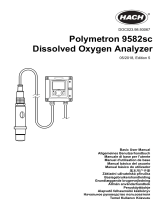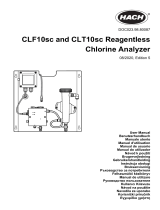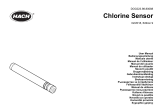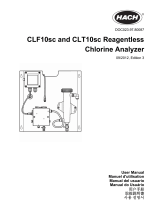Page is loading ...

MCL with 56 Analyzer
Instruction Manual
PN 51-MCL-56/rev A
March 2012

ESSENTIAL INSTRUCTIONS
READ THIS PAGE BEFORE PROCEEDING!
Your purchase from Rosemount Analytical, Inc. has
resulted in one of the finest instruments available for
your particular application. These instruments have
been designed, and tested to meet many national
and international standards. Experience indicates
that its performance is directly related to the quality
of the installation and knowledge of the user in oper-
ating and maintaining the instrument. To ensure
their continued operation to the design specifica-
tions, personnel should read this manual thoroughly
before proceeding with installation, commissioning,
operation, and maintenance of this instrument. If
this equipment is used in a manner not specified by
the manufacturer, the protection provided by it
against hazards may be impaired.
• Failure to follow the proper instructions may
cause any one of the following situations to
occur: Loss of life; personal injury; property dam-
age; damage to this instrument; and warranty
invalidation.
• Ensure that you have received the correct model
and options from your purchase order. Verify that
this manual covers your model and options. If
not, call 1-800-854-8257 or 949-757-8500 to
request correct manual.
• For clarification of instructions, contact your
Rosemount representative.
• Follow all warnings, cautions, and instructions
marked on and supplied with the product.
• Use only qualified personnel to install, operate,
update, program and maintain the product.
• Educate your personnel in the proper installation,
operation, and maintenance of the product.
• Install equipment as specified in the Installation
section of this manual. Follow appropriate local
and national codes. Only connect the product to
electrical and pressure sources specified in this
manual.
• Use only factory documented components for
repair. Tampering or unauthorized substitution of
parts and procedures can affect the performance
and cause unsafe operation of your process.
• All equipment doors must be closed and protec-
tive covers must be in place unless qualified per-
sonnel are performing maintenance.
• If this equipment is used in a manner not speci-
fied by the manufacturer, the protection provided
by it against hazards may be impaired.
Equipment protected throughout by double insulation.
• Installation of cable connections and servicing of this product
require access to shock hazard voltage levels.
• Main power and relay contacts wired to separate power
source must be disconnected before servicing.
• Do not operate or energize instrument with case open!
• Signal wiring connected in this box must be rated at least
240 V.
• Non-metallic cable strain reliefs do not provide grounding
between conduit connections! Use grounding type bushings
and jumper wires.
• Unused cable conduit entries must be securely sealed by
non-flammable closures to provide enclosure integrity in
compliance with personal safety and environmental protection
requirements. Unused conduit openings must be sealed with
NEMA 4X or IP65 conduit plugs to maintain the ingress
protection rating (NEMA 4X).
• Electrical installation must be in accordance with the National
Electrical Code (ANSI/NFPA-70) and/or any other applicable
national or local codes.
• Operate only with front and rear panels fastened and in place
over terminal area.
• Safety and performance require that this instrument be
connected and properly grounded through a three-wire
power source.
• Proper relay use and configuration is the responsibility of the
user.
Emerson Process Management
2400 Barranca Parkway
Irvine, CA 92606 USA
Tel: (949) 757-8500
Fax: (949) 474-7250
http://www.rosemountanalytical.com
© Rosemount Analytical Inc. 2012
CAUTION
WARNING
This product is not intended for use in the light industrial,
residential or commercial environments per the instrument’s
certification to EN50081-2.
This product generates, uses, and can radiate radio frequency
energy and thus can cause radio communication interference.
Improper installation, or operation, may increase such interfer-
ence. As temporarily permitted by regulation, this unit has not
been tested for compliance within the limits of Class A comput-
ing devices, pursuant to Subpart J of Part 15, of FCC Rules,
which are designed to provide reasonable protection against
such interference. Operation of this equipment in a residential
area may cause interference, in which case the user at his own
expense, will be required to take whatever measures may be
required to correct the interference.
WARNING
RISK OF ELECTRICAL SHOCK

QUICK START GUIDE
FOR MCL-240 ANALYZER
1. Refer to Section 2.0 for installation instructions and Section 3.0 for wiring instructions.
2. Once connections are secure and verified, apply power to the analyzer.
3. When the analyzer is powered up for the first time Quick Start screens appear.
4. The first quick start screen has two control boxes, one for language and the other for temperature units.
a. The cursor, shown by dark blue backlighting, will be on the language control box. To change the language,
press the ENTER/MENU key. A list of available languages, shown two at a time, will appear. Using the up
and down keys, scroll (see section 4.2) to display the choices. Press ENTER/MENU to select the desired
language. Press the down key to move to the cursor to the temperature control box. To change units,
press ENTER/MENU and scroll to either °F or °C. Press ENTER/MENU to store the selection.
b. To move to the next screen, use the navigation keys to move the cursor to NEXT and press
ENTER/MENU.
5. The next screen lists navigation rules. Press ENTER/MENU for the next screen.
6. Choose monochloramine.
7. Choose the desired units.
8. The display will change to show some basic keypad operation guidelines. Press ENTER/MENU to show the
main display.

About This Document
This manual contains instructions for installation and operation of the Model MCL-56
The following list provides notes concerning all revisions of this document.
Rev. Level
Date Notes
A9 /11 This is the initial release of the product manual. The manual has been
reformatted to reflect the Emerson documentation style and updated to
reflect any changes in the product offering.
B 03/12 Update addresses - mail and web

i
MODEL MCL–56 TABLE OF CONTENTS
MCL-56
TABLE OF CONTENTS
Section Title Page
1.0 DESCRIPTION AND SPECIFICATIONS ................................................................ 1
1.1 Features .................................................................................................................. 1
1.2 Specifications - General ........................................................................................... 2
1.3 Specifications - Sensor ............................................................................................ 2
1.4 Specifications - Analyzer.......................................................................................... 2
1.5 Ordering Information ................................................................................................ 3
2.0 INSTALLATION ....................................................................................................... 5
2.1 Unpacking and Inspection........................................................................................ 5
2.2 Installation................................................................................................................ 6
3.0 WIRING.................................................................................................................... 9
3.1 Power, Alarm, and Output Wiring............................................................................. 9
3.2 Sensor Wiring ......................................................................................................... 10
4.0 DISPLAY AND OPERATION ................................................................................... 13
4.1 Display ..................................................................................................................... 13
4.2 Keypad..................................................................................................................... 13
4.3 Operation ................................................................................................................. 14
4.4 Hold.......................................................................................................................... 16
4.5 Main Display ............................................................................................................ 17
4.6 Security .................................................................................................................... 18
5.0 PROGRAMMING THE ANALYZER ........................................................................ 19
5.1 Entering the Program Menus ................................................................................... 19
5.2 Outputs .................................................................................................................... 19
5.3 Relays ...................................................................................................................... 20
5.4 Measurement ........................................................................................................... 22
5.5 Temperature............................................................................................................. 22
5.6 Security .................................................................................................................... 23
5.7 Restoring Default Settings ....................................................................................... 23
6.0 CALIBRATION ........................................................................................................ 25
6.1 Introduction .............................................................................................................. 25
6.2 Entering the Calibration Menus................................................................................ 25
6.3 Calibrating Temperature........................................................................................... 25
6.4 Calibrating the Monochloramine Sensor ................................................................. 26
6.5 Calibrating the Analog Outputs ................................................................................ 27
6.6 Reset........................................................................................................................27

Section Title Page
7.0 DIGITAL COMMUNICATIONS ............................................................................... 29
8.0 DATA AND EVENT LOGGING AND RETRIEVAL .................................................. 31
8.1 Overview .................................................................................................................. 31
8.2 Configuration............................................................................................................ 31
8.3 Downloading Data and Events................................................................................. 32
8.4 Viewing Events......................................................................................................... 32
8.5 Date and Time.......................................................................................................... 32
9.0 GRAPHICAL DISPLAY .......................................................................................... 33
9.1 Overview .................................................................................................................. 33
9.2 Configuration............................................................................................................ 33
10.0 MAINTENANCE ..................................................................................................... 35
10.1 Analyzer ................................................................................................................... 35
10.2 Monochloramine Sensor .......................................................................................... 36
10.3 Constant Head Flow Controller................................................................................ 38
11.0 TROUBLESHOOTING ........................................................................................... 41
11.1 Overview .................................................................................................................. 41
11.2 Reading and Troubleshooting Fault and Warning Messages .................................. 41
11.3 Sensor Diagnostics .................................................................................................. 41
11.4 Troubleshooting Calibration Problems..................................................................... 42
11.5 Other Troubleshooting – Chlorine ............................................................................ 42
11.6 Simulating Inputs – Chlorine .................................................................................... 43
11.7 Simulating Inputs – Temperature ............................................................................. 44
LIST OF TABLES
Number Title Page
1.5 Ordering Information ............................................................................................... 3
1.5 Component Parts ..................................................................................................... 3
1.5 Accessories .............................................................................................................. 3
3.2 Sensor Wiring........................................................................................................... 10
4.1 Display Abbreviations ............................................................................................... 13
10.1 Spare Parts............................................................................................................... 37
10.2 Replacement Parts MCL .......................................................................................... 39
11.5 Troubleshooting – Chlorine ...................................................................................... 42
11.8 Simulating Inputs Temperature................................................................................. 44
MODEL MCL–56 TABLE OF CONTENTS
TABLE OF CONTENTS CONT’D
ii

LIST OF FIGURES
Number Title Page
2-1 Model MCL .................................................................................................... 7
3-1 Analog Output Connections ..................................................................................... 9
3-2 Alarm Relay Connections......................................................................................... 10
3-3 Wiring Diagram for Monochloramine Sensor .......................................................... 11
4-1 Main Display .................................................................................................... 13
4-2 Analyzer Keypad .................................................................................................... 13
5-1 Menu Tree for Outputs Sub Menu ........................................................................... 19
5-2 Menu Tree for Relays Sub Menu ............................................................................. 20
5-3 Menu Tree for Measurements Sub Menu ................................................................. 22
5-4 Menu Tree for Temperature Sub Menu .................................................................... 22
5-5 Menu Tree for Security Sub Menu............................................................................ 23
10-1 Chlorine Sensor Parts .............................................................................................. 37
10-2 Replacement Parts for the Flow Controller Assembly used in Model MCL .............. 39
11-1 Simulating Chlorine .................................................................................................. 43
11-2 Three-Wire RTD Configuration................................................................................. 44
11-3 Simulating RTD Inputs.............................................................................................. 44
iii
MODEL MCL–56 TABLE OF CONTENTS
LIST OF TABLES CONT’D

MODEL MCL–56
iv
This page left blank intentionally

1
MODEL MCL–56 SECTION 1.0
DESCRIPTION AND SPECIFICATIONS
SECTION 1.0.
DESCRIPTION AND SPECIFICATIONS
1.1 FEATURES
The MCL monochloramine system is intended for the
determination of monochloramine in fresh water.
The MCL uses a membrane-covered amperometric
sensor. A polarizing voltage applied to a gold mesh
cathode behind the membrane destroys the mono-
chloramine diffusing through the membrane and keeps
the concentration of monochloramine in the sensor
equal to zero. The current generated by the cathode
reaction is proportional to the rate of diffusion of
monochloramine through the membrane. Because the
concentration of monochloramine in the sensor is
zero, the diffusion rate and the current are proportional
to the concentration of monochloramine in the sample.
Diffusion rate also depends on membrane permeabili-
ty, which is a function of temperature. An RTD in the
sensor continuously measures the temperature of the
sample and the analyzer automatically corrects the
raw sensor current for temperature changes.
Maintenance is fast and easy. Replacing a membrane
requires no special tools or fixtures. A screw cap holds
the pre-tensioned membrane in place. Replacing the
electrolyte solution takes only minutes.
The MCL includes the easy-to-use Model 56 analyzer.
The analyzer features four fully programmable 4-20 mA
outputs and four fully programmable relays. The large,
full color display allows the user to read sample pH
and chlorine concentration at a glance.
A data logger, graphical display, and HART digital
communications are standard.
Valves, rotameters, and pressure regulators to control
sample flow are things of the past with the MCL. A
constant head overflow sampler ensures the correct
sample flow to each sensor. To eliminate wiring has-
sles, quick-disconnect Variopol cable is standard.
Stable monochloramine standards do not exist. The
monochloramine sensor must be calibrated using the
results of a laboratory test run on a grab sample.
• NO REAGENTS NEEDED
• COMPLETE SYSTEM INCLUDES sensor, connecting cable, analyzer, and flow controller.
• VARIOPOL QUICK-DISCONNECT FITTINGS make replacing sensor easy.
• FEATURE-PACKED ANALYZER: four outputs, four fully-programmable relays, data logger,
and large full color display including graphics.

1.2 SPECIFICATIONS — GENERAL
Sample requirements:
Pressure: 3 to 65 psig (122 to 549 kPa abs). Inlet
check valve opens at 3 psig (122 kPa abs). If the
check valve is removed, minimum pressure is 1
psig (108 kpa abs).
Temperature: 32 to 122°F (0 to 50°)
Flow: 3-80 gal/hr (11-303 L/hr)
Sample Conductivity: >10 µS/cm at 25°C
Process connection: ¼-in OD tubing compression fitting
(can be removed and replaced with barbed fitting for
soft tubing).
Drain connection: ¾-in barbed fitting. Sample must
drain to open atmosphere.
Wetted parts: acrylic, nylon, polycarbonate, polyester,
Kynar
(1)
, silicone, Noryl
(2)
, Viton
(3)
, silicone, and
Zitex
(4)
, PTFE, (gold mesh cathode - not normally
wetted)
Response time to step change in monochloramine
concentration: <60 sec to 95% of final reading for
inlet sample flow of 17 gph (64 L/hr).
Weight/shipping weight: 10 lb/13 lb (4.5 kg/6.0 kg)
[rounded to the nearest 1 lb. (0.5 kg)]
1.3 SPECIFICATIONS — SENSOR
Range: 0 to 6 ppm as Cl
2
. For higher ranges, consult
the factory.
pH range: Signal is practically independent of pH
between pH 7.0 and 10.0. Sensor current at pH 10.0
is within 5% of sensor current at pH 7.0.
Accuracy: Accuracy depends on the accuracy of the
chemical test used to calibrate the sensor.
Linearity: 2% (typ.)
Interferences: free chlorine and other oxidizing agents
Electrolyte volume: 25 mL (approx.)
Electrolyte life: 2 months (approx.)
1.4 SPECIFICATIONS — ANALYZER
Case: Polycarbonate
Display: Full color LCD, 3.75 x 2.20 in. (95 x 56 mm);
display can be customized by the user.
Languages: English, French, German, Italian, Spanish,
Portuguese, Chinese, Russian, and Polish.
Ambient Temperature and Humidity: 14 to 140°F
(-10 to 60°C); RH 5 to 95% (non-condensing).
Between 23 and 131°F (-5 to 55°C) there is no visi-
ble degradation in display response or performance.
Storage temperature: -4 to 140°F (-20 to 60°C)
Power: 85 to 265 VAC, 47.5 to 65.0 Hz, 20 W
RFI/EMI: EN-61326
LVD: EN-6101-01
Outputs: Four 4-20 or 0-20 mA isolated current outputs;
assignable to measurement or temperature; fully
scalable; maximum load 550 Ω. HART digital signal
is superimposed on output 1.
Alarms and Timers: Four relays, fully configurable as
a setpoint alarm, interval timer, TPC, bleed and
feed timer, delay timer, date and time timer, and
fault alarm.
Relays: Form C, SPDT, epoxy sealed.
Relay Contact ratings:
5 A at 28 VDC or 300 VAC (resistive)
1/8 HP at 120/240 VAC
Control features: PID control (analog output) and time
proportional control or TPC (relays) are standard.
Data logger: Data automatically stored every 30 seconds
for 30 days; older data removed to make room for
new data. The following data are automatically stored:
Chlorine: date and time, ppm, temperature, raw
sensor current
pH: date and time, pH, temperature, mV, glass
impedance, and reference impedance (if available)
Event logger: Stores up to 300 events with data and
time stamp: faults, warnings, calibration data, cali-
bration results (pass or fail), power on/off cycles, and
hold on/off. Alarm relay activation and deactivation
can also be stored. Older events are automatically
removed to make room for new events.
Data and event downloading: through USB port on
front panel.
Graphical display: Dual graphical display shows
measurement data on the y-axis and time on the
x-axis. Y-axis is fully assignable and scalable. X-
axis can be set to one hour, one day, seven days,
or 30 days.
Digital communications: HART digital communica-
tions is standard.
2
MODEL MCL–56 SECTION 1.0
DESCRIPTION AND SPECIFICATIONS
1
Kynar is a registered trademark of Elf Atochem North America.
2
Noryl is a registered trademark of General Electric.
3
Viton is a registered trademark of E.I. duPont de Nemours & Co.
4
Teflon is a registered trademark of E.I. duPont de Nemours & Co.

3
MODEL MCL–56 SECTION 1.0
DESCRIPTION AND SPECIFICATIONS
1.5 ORDERING INFORMATION
MCL Monochloramine Measuring System. The MCL is a complete system for the determination of monochlo-
ramine in water. It consists of the sensor, analyzer, Variopol cable, and constant head overflow cup to control
sample flow. All components are mounted on a backplate, and the cable is pre-wired to the analyzer. Three
replacement membranes and a 4-oz. bottle of electrolyte solution are shipped with the sensor.
ACCESSORIES
PART # DESCRIPTION
9240048-00 Tag, stainless steel (specify marking)
COMPONENT PARTS
ANALYZER MODEL DESCRIPTION
56-03-24-38-HT 56 analyzer, single input (monochloramine), 85-265 VAC, 47.5/65.0 Hz
SENSOR MODEL DESCRIPTION
499ACL-03-54-VP Monochloramine sensor with Variopol connector
SENSOR CABLE DESCRIPTION
23747-04 Interconnecting cable, Variopol for 499ACL sensor, 4 ft
MCL-240 Monochloramine Measuring System
MODEL DESCRIPTION
MCL-240 EXAMPLE

4
MODEL MCL–56 SECTION 1.0
DESCRIPTION AND SPECIFICATIONS
This page left blank intentionally

5
SECTION 2.0.
INSTALLATION
MODEL MCL–56 SECTION 2.0
INSTALLATION
2.1 UNPACKING AND INSPECTION
Inspect the shipping container. If it is damaged, contact the shipper immediately for instructions. Save the box. If
there is no apparent damage, unpack the container. Be sure all items shown on the packing list are present. If items
are missing, notify Rosemount Analytical immediately.
2.1.1 MCL-240
Model MCL-240 consists of the following items mounted on a back plate.
1. Model 56-03-24-38-HT analyzer with sensor cable attached.
2. Constant head flow controller with flow cell for monochloramine sensor.
The monochloramine sensor (Model 499ACL-03-54-VP), three membrane assemblies, and a bottle of electrolyte
solution are in a separate package.

6
MODEL MCL–56 SECTION 2.0
INSTALLATION
2.2 INSTALLATION
2.2.1 General Information
1. Although the system is suitable for outdoor use, do not install it in direct sunlight or in areas of extreme
temperature.
2. To keep the analyzer enclosure watertight, install plugs (provided) in the unused cable openings.
3. Install the system in an area where vibrations and electromagnetic and radio frequency interference are min-
imized or absent.
4. Be sure there is easy access to the analyzer and sensors.
2.2.2 Sample Requirements
Be sure the sample meets the following requirements:
1. Temperature: 32 to 122ºF (0 to 50ºC)
2. Pressure: 3 to 65 psig (122 to 549 kPa abs)
3. Minimum flow: 3 gal/hr (11 L/hr)
2.2.3 Mounting, Inlet, and Drain Connections
The MCL is intended for wall mounting only. Refer to Figure 2-1 for details. The sensor screws into the flow cell
adapters as shown in the figure.
A 1/4-inch OD tubing compression fitting is provided for the sample inlet. If desired, the compression fitting can
be removed and replaced with a barbed fitting. The fitting screws into a 1/4-inch FNPT check valve. The check
valve prevents the flow cells from going dry if sample flow is lost.
The sample drains through a 3/4-inch barbed fitting. Attach a piece of soft tubing to the fitting and allow the waste
to drain open atmosphere. Do not restrict the drain line.
Adjust the sample flow until the water level is even with the central overflow tube and excess water is flowing down
the tube.
2.2.4 Electrical Connections
Refer to Section 3.1 for details.
2.2.5 Installing the Sensor(s)
The MCL is provided with sensor cables pre-wired to the analyzer. The terminal end of the sensor is keyed to
ensure proper mating with the cable receptacle. Once the key has slid into the mating slot, tighten the connection
by turning the knurled ring clockwise.
The sensor screws into the plastic fitting, which is held in the flow cell by the union nut. Do not remove the pro-
tective cap on the sensor until ready to put the sensor in service.
CAUTION
The MCL monochloramine analyzer is NOT suitable
for use in hazardous areas.

7
MODEL MCL–56 SECTION 2.0
INSTALLATION
FIGURE 2-1. MCL
INCH
MILLIMETER

8
MODEL MCL–56 SECTION 2.0
INSTALLATION
This page left blank intentionally

9
MODEL MCL–56 SECTION 3.0
WIRING
SECTION 3.0.
WIRING
3.1 POWER, ALARM, AND OUTPUT WIRING
3.1.1 Power
Wire AC mains power to the power supply board, which is mounted on the left hand side of the enclosure beneath
the gray plastic cover. To remove the cover, grab it by the upper edges and pull straight out. The power connector
is at the bottom of the board. See Figure 3-2. Bring the power cable through the conduit opening just below the con-
nector. Unplug the connector from the board and wire the power cable to it. Lead connections are marked on the
connector. (L is live or hot; N is neutral; the ground connection has the standard symbol.)
Replace the cover. The two tabs on the back edge of the cover fit into slots at the rear of the enclosure, and the
three small slots in the front of the cover snap into the three tabs next to the relay terminal strip. See Figure 3-2.
Once the tabs are lined up, push
the cover to snap it in place.
AC power wiring should be 14
gauge or greater. Run the power
wiring through the conduit opening
nearest the power terminal.
Provide a switch or breaker to
disconnect the analyzer from the
main power supply. Install the
switch or breaker near the analyzer
and label it as the disconnecting
device for the analyzer.
3.1.2 Analog output wiring
Four analog current outputs are
located on the main circuit
board, which is attached to the
inside of the enclosure door.
Figure 3-1 shows the location of
the terminals, the outputs they
are assigned to, and the polarity.
For best EMI/RFI protection, use
shielded output signal cable
enclosed in earth-grounded
metal conduit.
Keep output signal wiring sepa-
rate from power wiring. Do not
run signal and power or relay
wiring in the same conduit or
close together in a cable tray.
FIGURE 3-1. Analog output connections.
The analog outputs are on the main board near the
hinged end of the enclosure door.
Electrical installation must be in accordance with
the National Electrical Code (ANSI/NFPA-70)
and/or any other applicable national or local codes.
WARNING
RISK OF ELECTRICAL SHOCK

10
MODEL MCL–56 SECTION 3.0
WIRING
3.2 SENSOR WIRING
The Model MCL is provided with the sensor cable pre-wired to the analyzer. If it is necessary to replace the sen-
sor cable, refer to the instructions below.
1. Shut off power to the analyzer.
2. Loosen the four screws holding the front panel in place and let it drop down.
3. Locate the appropriate signal board.
4. Loosen the gland fitting and carefully push the sensor cable up through the fitting as you pull the board
forward to gain access to the wires and terminal screws. Disconnect the wires and remove the cable.
5. Insert the new cable through the gland and pull the cable through the cable slot.
6. Wire the sensor to the signal board. Refer to the wiring diagram in Figure 3-3.
7. Once the cable has been connected to the board, slide the board fully into the enclosure while taking up the
excess cable through the cable gland. Tighten the gland nut to secure the cable and ensure a sealed enclosure.
Slot 1 (left) Slot 2 (center)
communication input 1 (chlorine)
3.1.3 Alarm wiring.
The alarm relay terminal strip is located on the power
supply board, which is mounted on the left hand side of
the enclosure beneath the gray plastic cover. To remove
the cover, grab it by the upper edges and pull straight
out. The relay terminal strip is at the top of the board.
See Figure 3-2. Bring the relay wires through the rear
conduit opening on the left hand side of the enclosure
and make connections to the terminal strip.
Replace the cover. The two tabs on the back edge of
the cover fit into slots at the rear of the enclosure, and
the three small slots in the front of the cover snap into
the three tabs next to the relay terminal strip. See
Figure 3-2. Once the tabs are lined up, push the cover
to snap it in place.
Keep alarm relay wiring separate from signal wiring.
Do not run signal and power or relay wiring in the
same conduit or close together in a cable tray.
FIGURE 3-2. Alarm relay
connections.
WARNING
Exposure to some chemicals may degrade the sealing
properties used in the following devices: Zettler
Relays (K1-K4) PN AZ8-1CH12DSEA

11
MODEL MCL–56 SECTION 3.0
WIRING
Figure 3-3. Wiring Diagram for Monochloramine Sensor

12
MODEL MCL–56
This page left blank intentionally
/





